
Bitumen is an immensely viscous constituent of petroleum. Depending on its exact composition it can be a sticky, black liquid or an apparently solid mass that behaves as a liquid over very large time scales. In American English, the material is commonly referred to as asphalt. Whether found in natural deposits or refined from petroleum, the substance is classed as a pitch. Prior to the 20th century, the term asphaltum was in general use. The word derives from the Ancient Greek word ἄσφαλτος (ásphaltos), which referred to natural bitumen or pitch. The largest natural deposit of bitumen in the world is the Pitch Lake of southwest Trinidad, which is estimated to contain 10 million tons.
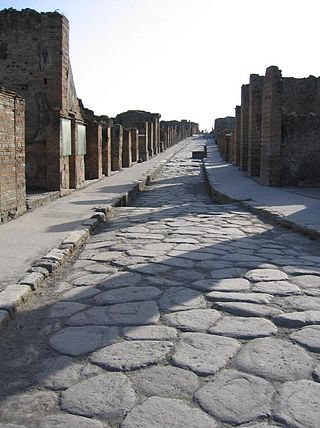
A sidewalk, pavement, footpath in Australia, India, New Zealand and Ireland, or footway is a path along the side of a road. Usually constructed of concrete, pavers, brick, stone, or asphalt, it is designed for pedestrians. A sidewalk is normally higher than the roadway, and separated from it by a kerb. There may also be a planted strip between the sidewalk and the roadway and between the roadway and the adjacent land.
Pavement or paving may refer to:

A street is a public thoroughfare in a built environment. It is a public parcel of land adjoining buildings in an urban context, on which people may freely assemble, interact, and move about. A street can be as simple as a level patch of dirt, but is more often paved with a hard, durable surface such as tarmac, concrete, cobblestone or brick. Portions may also be smoothed with asphalt, embedded with rails, or otherwise prepared to accommodate non-pedestrian traffic.
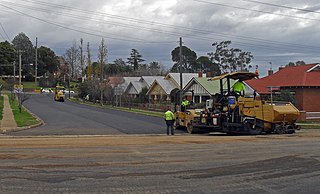
A road surface or pavement is the durable surface material laid down on an area intended to sustain vehicular or foot traffic, such as a road or walkway. In the past, gravel road surfaces, macadam, hoggin, cobblestone and granite setts were extensively used, but these have mostly been replaced by asphalt or concrete laid on a compacted base course. Asphalt mixtures have been used in pavement construction since the beginning of the 20th century and are of two types: metalled (hard-surfaced) and unmetalled roads. Metalled roadways are made to sustain vehicular load and so are usually made on frequently used roads. Unmetalled roads, also known as gravel roads or dirt roads, are rough and can sustain less weight. Road surfaces are frequently marked to guide traffic.

Asphalt concrete is a composite material commonly used to surface roads, parking lots, airports, and the core of embankment dams. Asphalt mixtures have been used in pavement construction since the beginning of the twentieth century. It consists of mineral aggregate bound together with bitumen, laid in layers, and compacted.

Permeable paving surfaces are made of either a porous material that enables stormwater to flow through it or nonporous blocks spaced so that water can flow between the gaps. Permeable paving can also include a variety of surfacing techniques for roads, parking lots, and pedestrian walkways. Permeable pavement surfaces may be composed of; pervious concrete, porous asphalt, paving stones, or interlocking pavers. Unlike traditional impervious paving materials such as concrete and asphalt, permeable paving systems allow stormwater to percolate and infiltrate through the pavement and into the aggregate layers and/or soil below. In addition to reducing surface runoff, permeable paving systems can trap suspended solids, thereby filtering pollutants from stormwater.
Beautification is the process of making visual improvements to a town, city, or urban area. This most often involves planting trees, shrubbery, and other greenery, but frequently also includes adding decorative or historic-style street lights and other lighting and replacing broken pavement, often with brick or other natural materials. Old-fashioned cobblestones are sometimes used for crosswalks; they provide the additional benefit of slowing motorists.

Portuguese pavement, known in Portuguese as calçada portuguesa or simply calçada, is a traditional-style pavement used for many pedestrian areas in Portugal. It consists of small pieces of stone arranged in a pattern or image, like a mosaic. It can also be found in Olivença and throughout former Portuguese colonies, especially in Brazil. Portuguese workers are also hired for their skill in creating these pavements in places such as Gibraltar. Being usually used in sidewalks, it is in town squares and atriums that this art finds its deepest expression.

A paver is a paving stone, tile, brick or brick-like piece of concrete commonly used as exterior flooring. They are generally placed on top of a foundation which is made of layers of compacted stone and sand. The pavers are placed in the desired pattern and the space between pavers is then filled with a polymeric sand. No actual adhesive or retaining method is used other than the weight of the paver itself except edging. Pavers can be used to make roads, driveways, patios, walkways and other outdoor platforms.
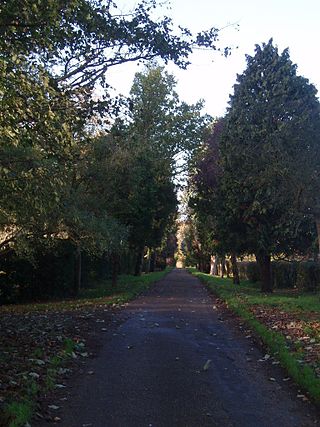
A driveway is a private road for local access to one or a small group of structures owned and maintained by an individual or group.
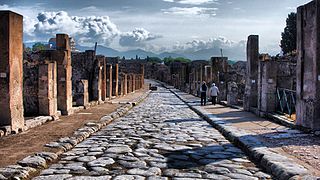
A curb or kerb is the edge where a raised sidewalk or road median/central reservation meets a street or other roadway.
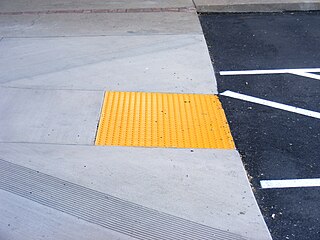
Tactile paving is a system of textured ground surface indicators found at roadsides, by and on stairs, and on railway station platforms, to assist pedestrians who are vision impaired.

Court Avenue is a small street in downtown Bellefontaine, Ohio, United States, located adjacent to the Logan County Courthouse. First paved in 1893, it is known for being the first street in the United States to be paved with concrete.

A sett, also known as a block or Belgian block, is a broadly rectangular quarried stone used in paving roads and walkways. Formerly in widespread use, particularly on steeper streets because setts provided horses' hooves with better grip than a smooth surface, they are now encountered rather as decorative stone paving in landscape architecture. Setts are often referred to as "cobblestones", although a sett is distinct from a cobblestone in that it is quarried or worked to a regular shape, whereas the latter is generally a small, naturally-rounded rock. Setts are usually made of granite.

Nicolson pavement, alternatively spelled "Nicholson" and denominated wooden block pavement and wood block pavement, is a road surface material consisting of wooden blocks. Samuel Nicolson invented it in the mid-19th century. Wooden block pavement has since become unfavored because of its poor surface quality and high cost of maintenance.

Panfilov Street Promenade is a promenade located in Almaty, Kazakhstan. The Abay Opera House, where the promenade starts, and KBTU Building are located within it, which was redesigned by Danish urban designer Jan Gehl. The promenade ends in Arbat.

Cobblestone mosaics can be found throughout Freiburg im Breisgau. Most mosaics are embedded in the cobblestone pavement of the city centre of Freiburg.

Roslyn Place is a small wooden-paved cul-de-sac located in the Shadyside neighborhood of Pittsburgh, Pennsylvania. The street was built in 1914 in the Nicolson Pavement style and is home to the historic Roslyn Place district.























